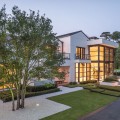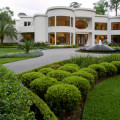Contemporary Patio

Many people do not realize that a contemporary patio is actually less expensive to build than a deck. This is particularly true when more standard costs materials are selected, and when no masonry walls are built around its perimeter. This not only makes such a custom patio a true money saver to construct, but also to preserve. The materials used to build it tend to be very tough, and they will provide decades of enjoyable outdoor living without having to be reworked or maintained.
Another advantage that these hardscapes offer is a near-infinite diversity of design styles. Unlike traditional landscaping designs which have a set of formal parameters that must be followed, contemporary and modern landscaping styles create their own rules subjective to the experience at hand.
This means that all the professional hardscape designer then has to do is to build the surface in proper relationship to its surroundings. Ideally, it will be characterized in the end by a geometry that either reflects or compliments that of the house, and that establishes repeating patterns of linearity and/or radial movements throughout the remainder of the yard.
All types of eclectic outdoor furnishings can then be added to the contemporary patio. Thanks to new developments in weather-resistant fabric manufacturing, homeowners can populate their outdoor seating areas with furnishing that equivocate to indoor comfort and style. Everything from ottomans to chairs and dining room tables can be obtained and arrange in patterns that further develop the geometry and theme of modern landscaping design.
When it comes to vegetation, we recommend against planting too many different kinds of plants and flowers. Excessive color works against the innate minimalism of contemporary landscape design. Instead, it is much better to plant darker species that better accent stone, concrete, and gravel. Color should be singular and focused sharply, not scattered abroad.
The whole point, again, is to use plant material to support geometry and repetition in order to create a sense of calculation, chosen purpose, and the understanding of complex relationships between abstract realms.
One way to do this is to plant very low-level ground cover around the borders of a contemporary patio in order to lend it emphasis. We can also plant bamboo and small trees to create vertical impact. Sometimes we even remove a portion of the patio and turn the empty space into a planter for a small tree or an Aloe Vera.
Any material that is used to build other hardscapes can be used to build a contemporary patio. Just a few of these materials are listed below.
Real Stone
When stone is finished and polished, it is the very best material to use for building any hardscape. The costs are significant, however, because it is expensive to cut and finish the stone to this level of refinement. You also have to pay for higher labor rates because stone must be hand laid with careful, methodical, and deliberate attention.
Cultured Stone
Stone veneer is lighter and less expensive than real stone. It is a manufactured material that imitates real stone, but it does not have to be quarried and polished. Veneer can be cut with saws and laid out in blocks on the ground like bricks.
Concrete
Plain concrete works very well with any contemporary landscape and is therefore an excellent material to use for building a contemporary patio. Concrete conveys a sense of very stark absolutes that go hand-in-hand with the rugged Mentalism of modern outdoor landscaping.
Of course, it may be better to make even a contemporary patio look more decorative if doing so better compliments the home. If such is the case, the concrete can be stamped or stained in order to make it appear more like finished stone.
Brick
Brick is good for smaller patios and for building custom hardscapes that are circular in design. There are many patterns we can create with bricks that generate radii and linear expansions of movement.




